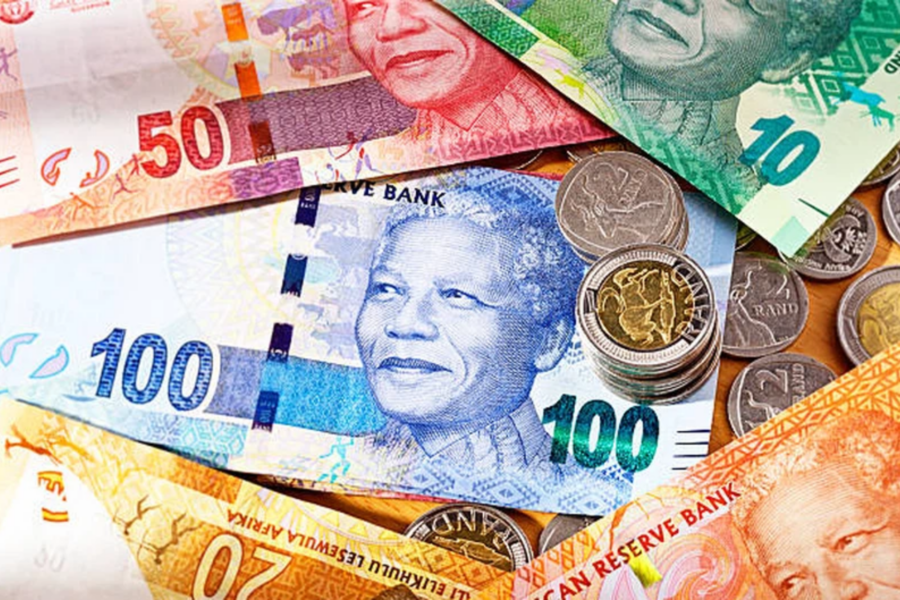
South African rand extended gains after inflation slows
The South African rand extended gains to trade about 1% stronger against the U.S. dollar on Wednesday, after July inflation data came in lower than expected.

Reuters: The South African rand extended gains to trade about 1% stronger against the U.S. dollar on Wednesday, after July inflation data came in lower than expected.
SOUTH AFRICAN RAND EXTENDED GAINS
At 1325 GMT, the rand traded at 18.5900 to the U.S. dollar, about 1.2% stronger than its previous close. The dollar last traded about 0.2% stronger against a basket of global currencies. The rand had gained as much as 1% on Tuesday as risk appetite returned to global markets due to falling U.S. Treasury yields.
Statistics South Africa said annual headline consumer inflation slowed to 4.7% in July from 5.4% in June, a bigger drop than the 5.0% rate analysts polled by Reuters had predicted and near the midpoint of the central bank’s target range. The figures will likely inform the SARB’s interest rate decision when it meets in September, but some analysts said inflation could rise again in August. “The inflation rate is likely to lift somewhat in August on base effects as July 2022 proved to be the peak for the inflation trajectory,” Investec economist Annabel Bishop said in a research note.
ALSO READ: Who are the richest South Africans in the world today? – 24 August 2023
South Africa is hosting leaders from Brazil, India and China in Johannesburg for the second day of the BRICS summit of emerging economies on Wednesday, where the expansion of the bloc is up for discussion. Russian President Vladimir Putin is joining virtually. South Africa’s benchmark 2030 government bond was stronger, with the yield down 18.5 basis points to 10.290%.
U.S. DOLLAR
Reuters: The dollar nursed a sharp pullback against Asian currencies on Thursday, after softer-than-expected global economic data muddied the interest rate outlook and pushed down U.S. yields ahead of the Federal Reserve’s Jackson Hole symposium. The Australian dollar, which has been taking a battering for a few months on signs of China’s slowdown and resilience in the U.S., jumped 0.9% overnight after U.S. manufacturing and services PMIs missed expectations. “Weaker than expected, data led markets to scale back their expectations for U.S. policy,” said Commonwealth Bank of Australia currency strategist Carol Kong, with jobless claims the next focus ahead of Fed Chair Jerome Powell’s Friday speech.
The New Zealand dollar also leapt overnight, as did the yen, which crossed below 145 to the dollar for the first time in more than a week tracking a sharp move lower in U.S. Treasury yields. Further moves for the major pairs were only slight in Asia morning trade, leaving the Aussie at $0.6479, the kiwi at $0.5976 and the yen firming slightly to 144.64 per dollar. The dollar index, which measures the greenback against a basket of six major currencies remains higher for the month, but dipped about 0.2% overnight. PMI data was soft globally, which tempered gains for the euro and sent sterling on a wide-ranging round trip before it steadied around $1.2717.
ALSO READ: Who is the richest person in the world today? Top 10 list – 24 August 2023
The euro held at $1.0865 in early Asia trade. Europe’s contraction in manufacturing output extended and services activity fell into decline, overnight surveys showed. British factory output slumped, leaving the economy on course for recession. U.S. business activity growth was its weakest since February as the economy seems to be starting to stall. Ten-year U.S. yields tumbled 13 basis points to 4.198%, their sharpest one-day slide in more than three months, which has taken some of the heat out of recent rises.
“The dollar’s correlation with rate differentials has been very strong in recent weeks,” said Standard Chartered’s head of G10 FX research, Steve Englander. “However, concerns on global and China growth may be high enough for any slippage in yields that pushes the dollar lower to be seen as a buy-USD, sell-bonds opportunity,” he said. “Our baseline remains that the USD is vulnerable on a medium-term horizon, but in the short term, it is unclear how big a shift in the Fed outlook is needed to reverse current market trends.” China’s yuan, which has been supported by state-bank buying in recent sessions, was steady at 7.2864 in thin offshore trade.
BRITISH POUND
Reuters: The British pound was on track for its biggest daily drop against the dollar in almost a month after a survey showed a slump in UK business activity in August, prompting a scaling back of expectations for where interest rates will peak. The S&P Global/CIPS Purchasing Managers’ Index tumbled to 47.9 in August from 50.8 in July, according to a preliminary estimate, the lowest level since January 2021. The manufacturing PMI dropped from 45.3 to 42.5, its lowest since May 2020, while the services sector index fell from 51.5 to 48.7, matching January’s two-year low.
ALSO READ: South Africa inflation drops to lowest level in TWO years: Latest numbers
“Importantly the services and composite PMI are both now below 50 and in contractionary territory,” said Kirstine Kundby-Nielsen, analyst at Danske Bank. “It’s a sign some of the past rate increases from the Bank of England are starting to feed through and that’s reflected in the move in the pound today,” Kundby-Nielsen added. The pound was last down 0.8% against the dollar to $1.2632, its lowest level since Aug. 14, and its biggest daily drop against the greenback since July 27.
It slipped 0.4% against the euro, with the single currency buying 85.56 pence, having earlier reached its highest level against the euro in 12 months after a survey showed German business activity contracted at the fastest pace in more than three years in August. The softer data has seen money market traders scale back bets on where Bank of England rates will peak. The central bank has raised rates 14 times since December 2021, taking them to their highest level since 2015 at 5.25%.
Markets had expected them to peak at 6%, but now see just two more 25 basis point rate rises to 5.75%. Jordan Rochester, senior G10 FX strategist at Nomura, expects the pound to fall to $1.22 as more evidence of a slowdown builds and the BoE pauses rate hikes later this year. “Yesterday it was the CBI that said the UK doesn’t have an inflation problem today it’s the PMIs,” Rochester said, referencing data on Tuesday from the Confederation of British Industry that showed manufacturers’ output price expectations fell to their lowest since February 2021.
ALSO READ: South Africa records two-year low inflation of 4.7%
GLOBAL MARKETS
Reuters: Asian shares rallied on Thursday after blockbuster results from tech darling Nvidia boosted Wall Street and a retreat in U.S. bond yields eased pressure on borrowing costs globally. A round of soft surveys on manufacturing had also revived hopes central banks were done tightening, though that might change depending on what clues about interest rates Federal Reserve Chairman Jerome Powell gives at an annual central bank summit in Jackson Hole, Wyoming, on Friday. “Equities rallied and bond yields retreated as flash PMI data for August signalled weaker economic activity in the U.S., euro area and UK, fuelling market expectations that central banks may not have to raise rates again,” said analysts at ANZ in a note.
“This week’s Jackson Hole Symposium remains firmly in focus for markets. We expect Powell will err on the side of caution with respect to inflation, noting some signs of improvement but still with a long way to go.” Investors will also be monitoring interest rate decisions and policy guidance from South Korea and Indonesia on Thursday. Early in the Asian trading day, MSCI’s broadest index of Asia-Pacific shares outside Japan was up 0.7%, also lifted by Nvidia’s bullish outlook. The index is however down 8.1% so far this month due to the weakness in China’s economy and yuan, as well as some gloomy factory readings from Japan, which also left sentiment fragile.
U.S. stock futures, the S&P 500 e-minis, rose 0.5%. Australian shares edged up 0.27%, while Japan’s Nikkei stock index rose 0.23%. China’s blue-chip CSI300 index was 0.51% higher in early trade. Hong Kong’s Hang Seng index opened up 0.82%. On Wednesday, U.S. stocks ended sharply higher across the board as shares of Nvidia jumped nearly 10% in trading after the bell, hitting an all-time high after it forecast third-quarter revenue well above Wall Street targets. On Wall Street, the Dow Jones Industrial Average rose 0.54%, the S&P 500 gained 1.10% and the Nasdaq Composite added 1.59%.
ALSO READ: Are ONIONS becoming a luxury in SA? Onion prices spike by 67% in a year
In U.S. Treasuries, the yield on benchmark 10-year Treasury notes reached 4.1879% compared with its U.S. close of 4.198% on Wednesday when it eased from near 16-year highs after weak business activity data from the United States and the euro zone. The two-year yield, which rises with traders’ expectations of higher Fed fund rates, touched 4.971% compared with a U.S. close of 4.952%. In currency markets, the dollar index dipped 0.03% in early Asia trade after hitting a two-month high of 103.4 against a basket of major currencies.
The yen recovered to 144.66 after hitting a nine-month trough of 145.34 amid talk from a former BOJ official that Japan will only intervene in the market if the currency plunges past 150 to the dollar. U.S. crude dipped 0.3% to $78.65 a barrel. Brent crude fell to $83.01 per barrel. Gold was slightly higher. Spot gold was traded at $1,918.89 per ounce.
Published by the Mercury Team on 24 August 2023
For more news on global and local market performance, follow our business and finance page.
